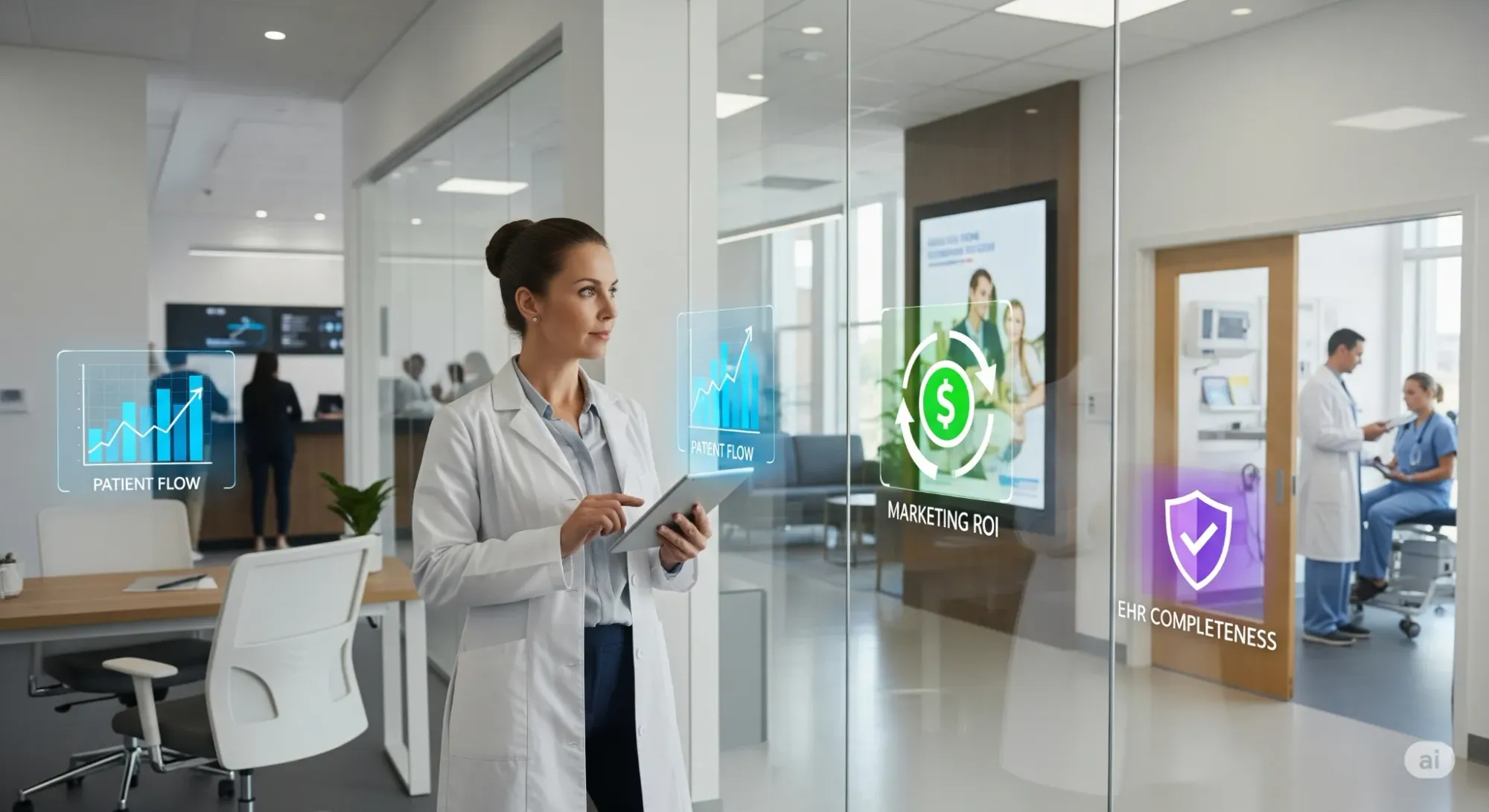
In recent years, healthcare management has evolved rapidly, driven by access to technologies that allow for the collection, organization, and interpretation of data in real-time. In this context, the concept of a data-driven clinic emerges: a care structure based on concrete information rather than subjective perceptions. It is a model that ensures greater predictability, control, and assertiveness in clinical, administrative, and financial decisions.
Managers who adopt this model can view their clinic as an integrated organism. Each piece of data generates a response that can direct growth, correct course, or prevent waste. Being data-driven means moving from reactivity to a strategic posture. In this article, we will cover what a data-driven clinic is and how to make yours smarter.
Before we continue, we need to ask: Are you already familiar with Ninsaúde Clinic? Ninsaúde Clinic is a medical software with an agile and complete schedule, electronic medical records with legal validity, teleconsultation, financial control and much more. Schedule a demonstration or try Ninsaúde Clinic right now!

What It Means to Be Data-Driven in Clinical Practice
Adopting data-driven management means allowing data to become the foundation for all choices made in the clinic. This is not limited to financial indicators but extends to team performance, patient experience, appointment efficiency, and the return on marketing campaigns.
For example, by analyzing scheduling and attendance data, it's possible to identify patterns of no-shows on certain days or times and, consequently, reallocate resources more effectively. In financial terms, by tracking the Customer Acquisition Cost (CAC), a manager can determine which marketing channels are most profitable. In patient care, well-maintained electronic health records help establish treatment patterns and facilitate more accurate diagnoses.
Being data-driven also means creating a culture of constant documentation and analysis, where everyone on the team understands that data is a valuable asset for continuous improvement. The clinic begins to operate like a health-tech company, where every decision is backed by numbers.

The Main Mistakes of Clinics That Don't Work with Data
Many clinics still rely on management based on habits and intuition. This informal approach is risky and often inefficient. The main mistakes include:
- Lack of standardized recording: When data is not organized or stored correctly, it becomes impossible to analyze it later.
- Absence of performance indicators: Without metrics, the manager doesn't know what is working or failing.
- Underestimation of small problems: Delays, cancellations, rework, or low patient adherence can be overlooked without proper analysis.
- Decisions based on "it's always been done this way": Without a culture of evaluation, the clinic repeats outdated models that hinder innovation.
These mistakes lead to consequences such as patient loss, high costs, and difficulty in growing. Worse, they create an illusion of stability when the clinic is actually vulnerable.

Essential Indicators to Assess the Health of the Clinic
For a clinic to become data-driven, it needs to periodically track Key Performance Indicators (KPIs). Some of the main ones include:
- Appointment schedule occupancy rate: Measures the utilization of professionals' schedules. A low rate indicates idle time.
- No-shows and cancellations: Helps identify flaws in appointment confirmation processes or patient retention.
- CAC (Customer Acquisition Cost): Reveals how much is being invested to acquire each new patient.
- ROI per marketing channel: Shows which strategies bring the best financial return.
- Revenue by insurance provider and by professional: Helps understand the profitability of each contract or employee.
These indicators should be analyzed in an integrated manner. For example, a paid media campaign might be bringing in many patients but with a high CAC and a low return rate. This is only noticeable with the right data.
Tools like Ninsaúde Clinic facilitate this tracking by offering automated reports and easy-to-interpret dashboards, providing a broad, real-time view of the clinic.
How to Interpret Data with a Managerial (and Not Just Operational) View
Having data is not enough: it must be understood with a managerial mindset. This means looking at the numbers and understanding their impact on the whole, not just on an isolated task.
An operational view focuses on day-to-day tasks, like scheduling appointments or issuing invoices. A managerial view, on the other hand, analyzes how these tasks influence revenue, patient relationships, and team productivity.
For example, if the no-show rate is high, it's not enough to blame the patients. A managerial view investigates whether the confirmation process is efficient, if professionals are running late with appointments, or if the patient experience is unsatisfactory. It is this type of reasoning that distinguishes an ordinary clinic from a smart one.
The Importance of Clear Visualization for Quick Decision-Making
Confusing spreadsheets, rigid systems, or overly technical reports make it difficult to extract insights. Data visualization needs to be clear, intuitive, and responsive.
Well-structured dashboards allow a manager to identify points of concern at a glance. Line charts, bar graphs, or heat maps, for example, are tools that transform raw data into understandable stories.
Solutions like Ninsaúde Clinic offer integration with Power BI and visual reports that facilitate this type of analysis. This way, even a manager who is not a technology expert can interpret indicators and act swiftly.
Data and Culture: How to Involve the Team in a Data-Driven Logic
A clinic only becomes truly data-driven when the entire team embraces this mindset. This includes receptionists, nurses, doctors, physical therapists, administrative staff, and managers.
Promoting this culture requires:
- Continuous training: Empower the team to understand the importance of data.
- Clear goals: Link indicators to the clinic's real objectives.
- Access to data: Allow teams to view data relevant to their roles.
- Performance-based recognition: Value results-oriented behaviors.
For example, a receptionist who monitors her confirmation rates and seeks to improve them is actively contributing to the clinic's operational intelligence. This collective participation creates a virtuous cycle of improvement.

From Diagnosis to Action: How to Turn Numbers into Real Improvements
Data only has value if it is used to generate concrete changes. This requires a structured cycle of continuous improvement:
- Diagnosis: Collect and analyze key indicators.
- Hypothesis: Identify the possible causes of problems.
- Action Plan: Propose solutions with goals and deadlines.
- Execution: Implement the changes with team involvement.
- Review: Monitor the effects and adjust as necessary.
This process transforms statistics into results. For example, upon noticing an increase in the average appointment time, the clinic can review its triage workflow, automate bureaucratic steps, or redistribute the schedule.
Long-Term Sustainability: Why Smart Clinics Grow More
A clinic that works with data not only improves its current performance but also prepares to grow securely. This happens because:
- Decisions are evidence-based: Reducing errors and rework.
- Investments are targeted: Prioritizing channels and resources with the highest return.
- Financial forecasting is more accurate: Avoiding surprises and imbalances.
- The patient experience is enhanced: Which increases loyalty and referrals.
Clinics that grow in a disorganized manner face problems like high patient debt, staff burnout, and a drop in quality. In contrast, smart clinics expand based on data, maintaining standards of excellence even in new contexts.
Solutions like Ninsaúde Clinic, with their BI features, integrations, and per-location dashboards, are great allies in this sustainable expansion process.

Intelligence in Healthcare is a Process, Not a Destination
Transforming your clinic into a data-driven structure is a journey of maturity. It starts with small steps: standardizing data, using reports, and setting goals. Over time, the data culture solidifies and begins to guide all decisions.
By adopting a smart mindset, you not only gain efficiency and control but also offer safer, more humane, and predictable care. In an increasingly competitive market, being data-driven is a differentiator that ensures relevance, growth, and longevity.
Liked the information? Then prepare for a continuous journey of knowledge by following our blog. Are you a health professional and not yet familiar with the benefits of Ninsaúde Clinic? Stay ahead, optimize your processes, and elevate excellence in patient care!
